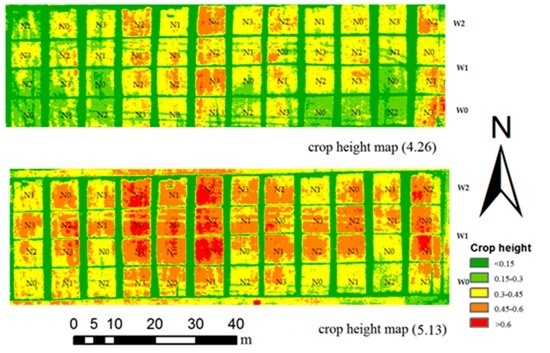Estimation of Winter Wheat Above-Ground Biomass Using Unmanned Aerial Vehicle-Based Snapshot Hyperspectral Sensor and Crop Height Improved Models
Abstract
:1. Introduction
2. Materials and Methods
2.1. Study Area
2.2. Data
2.2.1. AGB and Crop Height Measurement
2.2.2. Snapshot Hyperspectral Sensor
2.2.3. Platform
2.2.4. ASD Measurement
2.3. Methods
2.3.1. Selection of Spectral Bands and Indices
2.3.2. Winter Wheat Height
2.3.3. Partial Least Squares Regression
2.3.4. Precision Evaluation
3. Results
3.1. UHD Hyperspectral Data and Crop Height Analysis
3.1.1. Analysis of ASD and UHD Hyperspectral Data
3.1.2. Crop Height Estimation
3.2. Biomass Modeling
3.2.1. Hyperspectral Model
3.2.2. Crop Height Improved AGB Models
3.2.3. PLSR Methods to Improve the Estimation Accuracy
3.2.4. Mapping with Improved Models Based on Crop Height
4. Discussion
4.1. Stability and Redundancy of UHD Hyperspectral Data
4.2. Saturation of Hyperspectral Data and Crop Height Improvement for AGB Estimation
4.3. Two-Band Spectral Vegetation Indices and PLSR Methods
4.4. Crop Height and Ground Elevation Control Points
5. Conclusions
Acknowledgments
Author Contributions
Conflicts of Interest
References
- Wang, L.; Zhou, X.; Zhu, X.; Dong, Z.; Guo, W. Estimation of biomass in wheat using random forest regression algorithm and remote sensing data. Crop J. 2016, 4, 212–219. [Google Scholar] [CrossRef]
- Hensgen, F.; Bühle, L.; Wachendorf, M. The effect of harvest, mulching and low-dose fertilization of liquid digestate on above ground biomass yield and diversity of lower mountain semi-natural grasslands. Agric. Ecosyst. Environ. 2016, 216, 283–292. [Google Scholar] [CrossRef]
- Huang, J.; Sedano, F.; Huang, Y.; Ma, H.; Li, X.; Liang, S.; Tian, L.; Zhang, X.; Fan, J.; Wu, W. Assimilating a synthetic Kalman filter leaf area index series into the WOFOST model to improve regional winter wheat yield estimation. Agric. For. Meteorol. 2016, 216, 188–202. [Google Scholar] [CrossRef]
- He, L.; Chen, Z.; Jiang, Z.; Wen, B.; Wu, W.B.; Ren, J.; Liu, B.; Tuya, H. Comparative analysis of GF-1, HJ-1, and Landsat-8 data for estimating the leaf area index of winter wheat. J. Integr. Agric. 2016, 16, 266–285. [Google Scholar] [CrossRef]
- Soudani, K.; François, C.; Maire, G.L.; Dantec, V.; Dufrêne, E. Comparative analysis of IKONOS, SPOT, and ETM+ data for leaf area index estimation in temperate coniferous and deciduous forest stands. Remote Sens. Environ. 2006, 102, 161–175. [Google Scholar] [CrossRef]
- Jibo, Y.; Guijun, Y.; Haikuan, F. Comparative of remote sensing estimation models of winter wheat biomass based on random forest algorithm. Trans. Chin. Soc. Agric. Eng. 2016, 32, 175–182. [Google Scholar] [CrossRef]
- Campos, M.; García, F.J.; Camps, G.; Grau, G.; Nutini, F.; Crema, A.; Boschetti, M. Multitemporal and multiresolution leaf area index retrieval for operational local rice crop monitoring. Remote Sens. Environ. 2016, 187, 102–118. [Google Scholar] [CrossRef]
- Dong, Y.; Wang, J.; Li, C.; Yang, G. Comparison and Analysis of Data Assimilation Algorithms for Predicting the Leaf Area Index of Crop Canopies. IEEE J. Sel. Top. Appl. Earth Obs. Remote Sens. 2013, 6, 188–201. [Google Scholar] [CrossRef]
- Houghton, A.; Hall, F.; Goetz, J. Importance of biomass in the global carbon cycle. J. Geophys. Res. Biogeosci. 2009, 114, 1–13. [Google Scholar] [CrossRef]
- Badhwar, D.; Macdonald, B. Satellite-derived leaf-area-index and vegetation maps as input to global carbon cycle models-a hierarchical approach. Int. J. Remote Sens. 1986, 7, 265–281. [Google Scholar] [CrossRef]
- Liu, R.; Chen, M.; Liu, J.; Deng, F.; Sun, R. Application of a new leaf area index algorithm to China’s landmass using MODIS data for carbon cycle research. J. Environ. Manag. 2007, 85, 649–658. [Google Scholar] [CrossRef] [PubMed]
- Chen, Y.; Luo, Y.; Reich, B.; Searle, B.; Biswas, R. Climate change−associated trends in net biomass change are age dependent in western boreal forests of canada. Ecol. Lett. 2016, 19, 1150–1158. [Google Scholar] [CrossRef] [PubMed]
- Chen, Y.; Luo, Y. Net aboveground biomass declines of four major forest types with forest ageing and climate change in western canada’s boreal forests. Glob. Chang. Biol. 2015, 21, 3675–3684. [Google Scholar] [CrossRef] [PubMed]
- Adler, O.; Rosenberger, A.; Malberger, E.; Koenig, B.; Peleg, H. Relative contributions of climate change, stomatal closure, and leaf area index changes to 20th and 21st century runoff change: A modelling approach using the Organizing Carbon and Hydrology in Dynamic Ecosystems (ORCHIDEE) land surface model. J. Geophys. Res. Atmos. 2010, 115, 1383–1392. [Google Scholar] [CrossRef]
- Sankaran, S.; Khot, R.; Espinoza, Z.; Jarolmasjed, S.; Sathuvalli, R.; Vandemark, J.; Miklas, N.; Carter, H.; Pumphrey, O.; Knowles, R. Low-altitude, high-resolution aerial imaging systems for row and field crop phenotyping: A review. Eur. J. Agron. 2015, 70, 112–123. [Google Scholar] [CrossRef]
- Zarcotejada, J.; Guilléncliment, L.; Hernándezclemente, R.; Catalina, A.; González, R.; Martín, P. Estimating leaf carotenoid content in vineyards using high resolution hyperspectral imagery acquired from an unmanned aerial vehicle (UAV). Agric. For. Meteorol. 2013, 171–172, 281–294. [Google Scholar] [CrossRef]
- Bareth, G.; Aasen, H.; Bendig, J.; Gnyp, L.; Bolten, A.; Jung, A.; Michels, R.; Soukkamäki, J. Low-weight and UAV-based Hyperspectral Full-frame Cameras for Monitoring Crops: Spectral Comparison with Portable Spectroradiometer Measurements. Photogramm. Fernerkund. Geoinf. 2015, 69–79. [Google Scholar] [CrossRef]
- Aasen, H.; Burkart, A.; Bolten, A.; Bareth, G. Generating 3D hyperspectral information with lightweight UAV snapshot cameras for vegetation monitoring: From camera calibration to quality assurance. Isprs J. Photogramm. Remote Sens. 2015, 108, 245–259. [Google Scholar] [CrossRef]
- Uhd-185-Firefly. Available online: http://cubert-gmbh.com/uhd-185-firefly/ (accessed on 15 May 2017).
- Rouse, J.; Haas, H.; Schell, A.; Deering, W.; Harlan, C. Monitoring the Vernal Advancement of Retrogradation (Green Wave Effect) of Natural Vegetation; Type III, Final Report; NASA: Washington, DC, USA, 1974; pp. 1–371. Available online: https://ntrs.nasa.gov/archive/nasa/casi.ntrs.nasa.gov/19730009608.pdf (accessed on 15 May 2017).
- Huete, A. A soil-adjusted vegetation index (SAVI). Remote Sens. Environ. 1988, 25, 295–309. [Google Scholar] [CrossRef]
- Jordan, F. Derivation of Leaf−Area Index from Quality of Light on the Forest Floor. Ecology 1969, 50, 663–666. [Google Scholar] [CrossRef]
- Elmore, J.; Mustard, F.; Manning, J. Quantifying vegetation change in semiarid environments: Precision and accuracy of spectral mixture analysis and the normalized difference vegetation index. Remote Sens. Environ. 2000, 73, 87–102. [Google Scholar] [CrossRef]
- Jin, L.; Diao, Y.; Xiao, H.; Wang, Y.; Chen, B.; Wang, R. Estimation of wheat agronomic parameters using new spectral indices. PLoS ONE 2013, 8, e72736. [Google Scholar] [CrossRef] [PubMed]
- Jin, X.; Xu, X.; Song, X.; Li, Z.; Wang, J.; Guo, W. Estimation of leaf water content in winter wheat using grey relational analysis-partial least squares modeling with hyperspectral data. Agron. J. 2013, 105, 1385–1392. [Google Scholar] [CrossRef]
- Gitelson, A. Wide dynamic range vegetation index for remote quantification of biophysical characteristics of vegetation. J. Plant Physiol. 2004, 161, 165–173. [Google Scholar] [CrossRef] [PubMed]
- Pu, R.; Gong, P. Wavelet transform applied to eo-1 hyperspectral data for forest lai and crown closure mapping. Remote Sens. Environ. 2004, 91, 212–224. [Google Scholar] [CrossRef]
- Delegido, J.; Fernandez, G.; Gandia, S.; Moreno, J. Retrieval of chlorophyll content and lai of crops using hyperspectral techniques: Application to proba/chris data. Int. J. Remote Sens. 2008, 29, 7107–7127. [Google Scholar] [CrossRef]
- Meroni, M.; Colombo, R.; Panigada, C. Inversion of a radiative transfer model with hyperspectral observations for lai mapping in poplar plantations. Remote Sens. Environ. 2004, 92, 195–206. [Google Scholar] [CrossRef]
- Calderón, R.; Navas, J.A.; Lucena, C.; Zarco, P. High-resolution airborne hyperspectral and thermal imagery for early detection of Verticillium wilt of olive using fluorescence, temperature and narrow-band spectral indices. Remote Sens. Environ. 2013, 139, 231–245. [Google Scholar] [CrossRef]
- Li, W.; Niu, Z.; Chen, H.; Li, D.; Wu, M.; Zhao, W. Remote estimation of canopy height and aboveground biomass of maize using high-resolution stereo images from a low-cost unmanned aerial vehicle system. Ecol. Indic. 2016, 67, 637–648. [Google Scholar] [CrossRef]
- Gago, J.; Douthe, C.; Coopman, E.; Gallego, P.; Ribas, M.; Flexas, J.; Escalona, J.; Medrano, H. UAVs challenge to assess water stress for sustainable agriculture. Agric. Water Manag. 2015, 153, 9–19. [Google Scholar] [CrossRef]
- Ribeiro, K.; Hernandez, D.; Ballesteros, R.; Moreno, M. Approximate georeferencing and automatic blurred image detection to reduce the costs of UAV use in environmental and agricultural applications. Biosyst. Eng. 2016, 151, 308–327. [Google Scholar] [CrossRef]
- Bendig, J.; Bolten, A.; Bennertz, S.; Broscheit, J.; Eichfuss, S.; Bareth, G. Estimating biomass of barley using crop surface models (csms) derived from uav-based rgb imaging. Remote Sens. 2014, 11, 10395–10412. [Google Scholar] [CrossRef]
- Bendig, J.; Yu, K.; Aasen, H.; Bolten, A.; Bennertz, S.; Broscheit, J.; Gnyp, M.; Bareth, G. Combining UAV-based plant height from crop surface models, visible, and near infrared vegetation indices for biomass monitoring in barley. Int. J. Appl. Earth Obs. Geoinf. 2015, 39, 79–87. [Google Scholar] [CrossRef]
- Jannoura, R.; Brinkmann, K.; Uteau, D.; Bruns, C.; Joergensen, R. Monitoring of crop biomass using true colour aerial photographs taken from a remote controlled hexacopter. Biosyst. Eng. 2014, 129, 341–351. [Google Scholar] [CrossRef]
- Berni, J.; Zarcotejada, P.; Sepulcrecantó, G.; Fereres, E.; Villalobos, F. Mapping canopy conductance and CWSI in olive orchards using high resolution thermal remote sensing imagery. Remote Sens. Environ. 2009, 113, 2380–2388. [Google Scholar] [CrossRef]
- Vonbueren, S.; Burkart, A.; Hueni, A.; Rascher, U.; Tuohy, M.; Yule, I. Deploying four optical UAV-based sensors over grassland: Challenges and limitations. Biogeosciences 2015, 12, 163–175. [Google Scholar] [CrossRef]
- Vega, F.; Ramírez, F.; Saiz, M.; Rosúa, F. Multi-temporal imaging using an unmanned aerial vehicle for monitoring a sunflower crop. Biosyst. Eng. 2015, 132, 19–27. [Google Scholar] [CrossRef]
- Honkavaara, E.; Saari, H.; Kaivosoja, J.; Nen, L.; Hakala, T.; Litkey, P.; Kynen, J.; Pesonen, L. Processing and Assessment of Spectrometric, Stereoscopic Imagery Collected Using a Lightweight UAV Spectral Camera for Precision Agriculture. Remote Sens. 2013, 5, 5006–5039. [Google Scholar] [CrossRef]
- Moshou, D.; Bravo, C.; Oberti, R.; West, J.; Bodria, L.; McCartney, A.; Ramon, H. Plant disease detection based on data fusion of hyper-spectral and multi-spectral fluorescence imaging using Kohonen maps. Real-Time Imaging 2005, 11, 75–83. [Google Scholar] [CrossRef]
- Liu, J.; Zhao, C.; Yang, G.; Yu, H.; Zhao, X.; Xu, B.; Niu, Q. Review of field-based phenotyping by unmanned aerial vehicle remote sensing platform. Trans. Chin. Soc. Agric. Eng. 2016, 32, 98–106. [Google Scholar] [CrossRef]
- Fu, Y.Y.; Yang, G.J.; Wang, J.H.; Song, X.Y.; Feng, H.K. Winter wheat biomass estimation based on spectral indices, band depth analysis and partial least squares regression using hyperspectral measurements. Comput. Electr. Agric. 2014, 100, 51–59. [Google Scholar] [CrossRef]
- Nguyen, H.T.; Lee, B.W. Assessment of rice leaf growth and nitrogen status by hyperspectral canopy reflectance and partial least square regression. Eur. J. Agron. 2006, 24, 349–356. [Google Scholar] [CrossRef]
- Yang, G.J.; Zhao, C.J.; Xing, Z.R. LAI inversion of spring wheat based on PROBA/CHRIS hyperspectral multi-angular data and PROSAIL model. Trans. CSAE 2011, 27, 88–94. [Google Scholar] [CrossRef]
- Atzberger, C. Object-based retrieval of biophysical canopy variables using artificial neural nets and radiative transfer models. Remote Sens. Environ. 2004, 93, 53–67. [Google Scholar] [CrossRef]
- Yang, X.H.; Huang, J.F.; Wang, X.Z.; Wang, F.M. The estimation model of rice leaf area index using hyperspectral data based on support vector machine. Spectrosc. Spectr. Anal. 2008, 28, 1837. [Google Scholar] [CrossRef]
- Han, Z.Y.; Zhu, X.C.; Fang, X.Y.; Wang, Z.Y.; Wang, L.; Zhao, G.X. Hyperspectral estimation of apple tree canopy lai based on svm and rf regression. Spectrosc. Spectr. Anal. 2016, 36, 800–805. [Google Scholar] [CrossRef]
- Yuan, H.H.; Yang, G.J.; Li, C.C.; Wang, Y.J.; Liu, J.G.; Yu, H.Y.; Feng, H.K.; Xu, B.; Zhao, X.Q.; Yang, X.D. Retrieving Soybean Leaf Area Index from Unmanned Aerial Vehicle Hyperspectral Remote Sensing: Analysis of RF, ANN, and SVM Regression Models. Remote Sens. 2017, 9, 309. [Google Scholar] [CrossRef]
- China Meteorological Data. Available online: http://data.cma.cn/ (accessed on 15 May 2017).
- National Engineering Research Center for Information Technology in Agriculture. Available online: http://www.nercita.org.cn/English/e_index.asp (accessed on 15 May 2017).
- DJI. Available online: https://www.dji.com/ (accessed on 15 May 2017).
- Agisoft. Available online: http://www.agisoft.com/ (accessed on 15 May 2017).
- ENVI. Available online: http://www.harrisgeospatial.com/ProductsandSolutions/GeospatialProducts/ENVI.aspx (accessed on 15 May 2017).
- Pu, R.; Gong, P. Hyperspectral Remote Sensing of Vegetation Bioparameters. In Advances in Environmental Remote Sensing: Sensors, Algorithm, and Application; Weng, Q., Ed.; CRC Press: Boca Raton, FL, USA, 2011; pp. 101–142. [Google Scholar]
- Huete, A.; Didan, K.; Miura, T.; Rodriguez, E.; Gao, X.; Ferreira, L. Overview of the radiometric and biophysical performance of the MODIS vegetation indices. Remote Sens. Environ. 2002, 83, 195–213. [Google Scholar] [CrossRef]
- Jiang, Z.; Huete, A.; Didan, K.; Miura, T. Development of a two-band enhanced vegetation index without a blue band. Remote Sens. Environ. 2008, 112, 3833–3845. [Google Scholar] [CrossRef]
- Zarco, P.; Rueda, C.; Ustin, L. Water content estimation in vegetation with MODIS reflectance data and model inversion methods. Remote Sens. Environ. 2003, 85, 109–124. [Google Scholar] [CrossRef]
- Qi, J.; Chehbouni, A.; Huete, A.; Kerr, H.; Sorooshian, S. A modified soil adjusted vegetation index. Remote Sens. Environ. 1994, 48, 119–126. [Google Scholar] [CrossRef]
- Rondeaux, G.; Steven, M.; Baret, F. Optimization of soil−adjusted vegetation indices. Remote Sens. Environ. 1996, 55, 95–107. [Google Scholar] [CrossRef]
- Haboudane, D.; Miller, J.; Pattery, E.; Zarco, P.; Strachan, B. Hyperspectral vegetation indices and novel algorithms for predicting green LAI of crop canopies: Modeling and validation in the context of precision agriculture. Remote Sens. Environ. 2004, 90, 337–352. [Google Scholar] [CrossRef]
- Broge, H.; Leblanc, E. Comparing prediction power and stability of broadband and hyperspectral vegetation indices for estimation of green leaf area index and canopy chlorophyll density. Remote Sens. Environ. 2000, 76, 156–172. [Google Scholar] [CrossRef]
- Wold, H. Estimation of Principal Components and Related Models by Iterative Least Squares. J. Multivar. Anal. 1966, 1, 391–420. [Google Scholar]
- Darvishzadeh, R.; Skidmore, A.; Schlerf, M.; Atzberger, C.; Corsi, F.; Cho, M. Lai and chlorophyll estimation for a heterogeneous grassland using hyperspectral measurements. Isprs J. Photogramm. Remote Sens. 2008, 63, 409–426. [Google Scholar] [CrossRef]
- Gao, L.; Yang, G.; Yu, H.; Xu, B.; Zhao, X.; Dong, J.; Ma, Y. Retrieving winter wheat leaf area index based on unmanned aerial vehicle hyperspectral remoter sensing. Trans. Chin. Soc. Agric. Eng. 2016, 32, 113–120. [Google Scholar] [CrossRef]
- Cui, J.; Zhang, S.; Zhang, J. Determining surface magnetic susceptibility of loess-paleosol sections based on spectral features: Application to a UHD 185 hyperspectral image. Int. J. Appl. Earth Obs. Geoinf. 2016, 50, 159–169. [Google Scholar] [CrossRef]
- Sun, H.; Li, M.; Zhao, Y.; Zhang, Y.; Wang, X.; Li, X. The spectral characteristics and chlorophyll content at winter wheat growth stages. Spectrosc. Spectr. Anal. 2010, 30, 192–196. [Google Scholar] [CrossRef]
- Wang, J.; Zhao, C.; Huang, W. Fundamental and Application of Quantitative Remote Sensing in Agric, 1st ed.; Science China Press: Beijing, China, 2008; pp. 4–5. [Google Scholar]
- Yang, G. Cropland Radiative Transfer Model and Remote Sensing Imaging Simulation, 1st ed.; China Meteorological Press: Beijing, China, 2012; pp. 109–110. [Google Scholar]
- Wallace, L.; Musk, R.; Lucieer, A. An Assessment of the Repeatability of Automatic Forest Inventory Metrics Derived From UAV-Borne Laser Scanning Data. IEEE Trans. Geosci. Remote Sens. 2014, 52, 60–71. [Google Scholar] [CrossRef]
- Iiames, J.; Marks, W.; Lunetta, R.; Khorram, S.; Mace, T. Basal Area and Biomass Estimates of Loblolly Pine Stands using L-Band UAVSAR. Photogramm. Eng. Remote Sens. 2014, 80, 33–42. [Google Scholar] [CrossRef]
- Atzberger, C.; Guérif, M.; Baret, F.; Werner, W. Comparative analysis of three chemometric techniques for the spectroradiometric assessment of canopy chlorophyll content in winter wheat. Comput. Electr. Agric. 2010, 73, 165–173. [Google Scholar] [CrossRef]
- Mirzaie, M.; Darvishzadeh, R.; Shakiba, A.; Matkan, A.A.; Atzberger, C.; Skidmore, A. Comparative analysis of different uni-and multi-variate methods for estimation of vegetation water content using hyper-spectral measurements. Int. J. Appl. Earth Obs. Geoinf. 2014, 26, 1–11. [Google Scholar] [CrossRef]
- Jianqing, Z.; Li, P.; Shugen, W. Photogrammetry, 3rd ed.; Wuhan University Press: Wuhan, China, 2009; pp. 74–96. [Google Scholar]

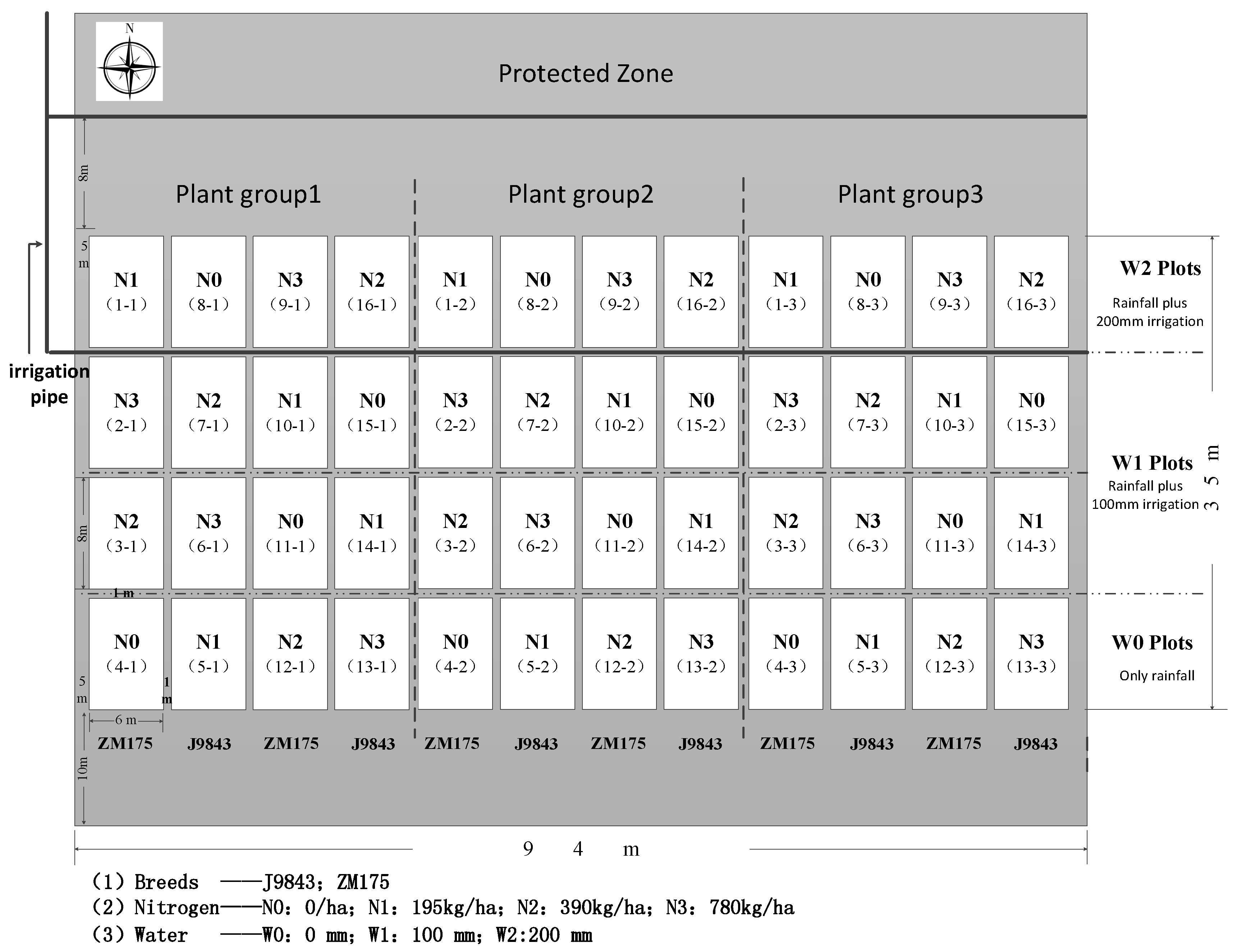
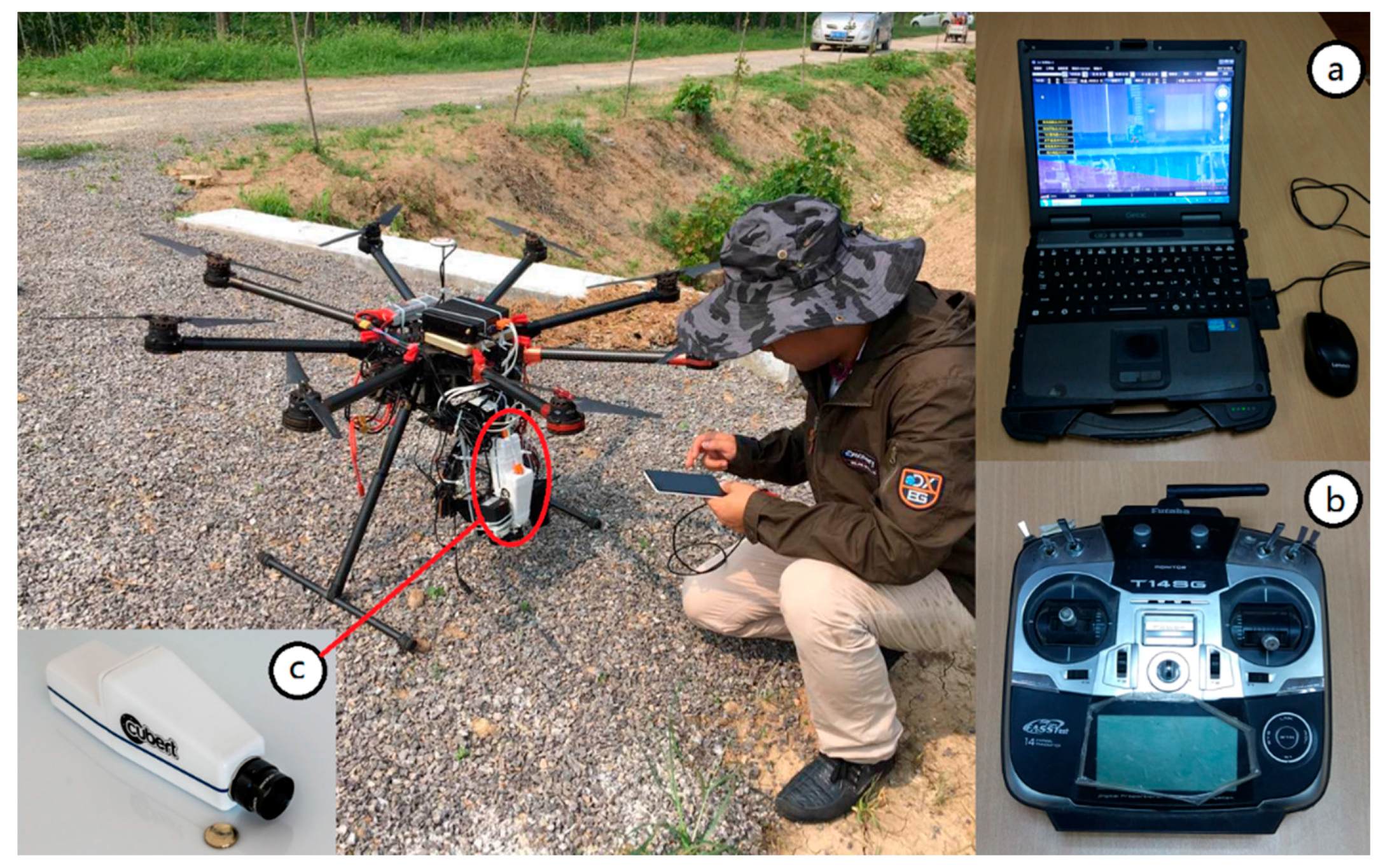
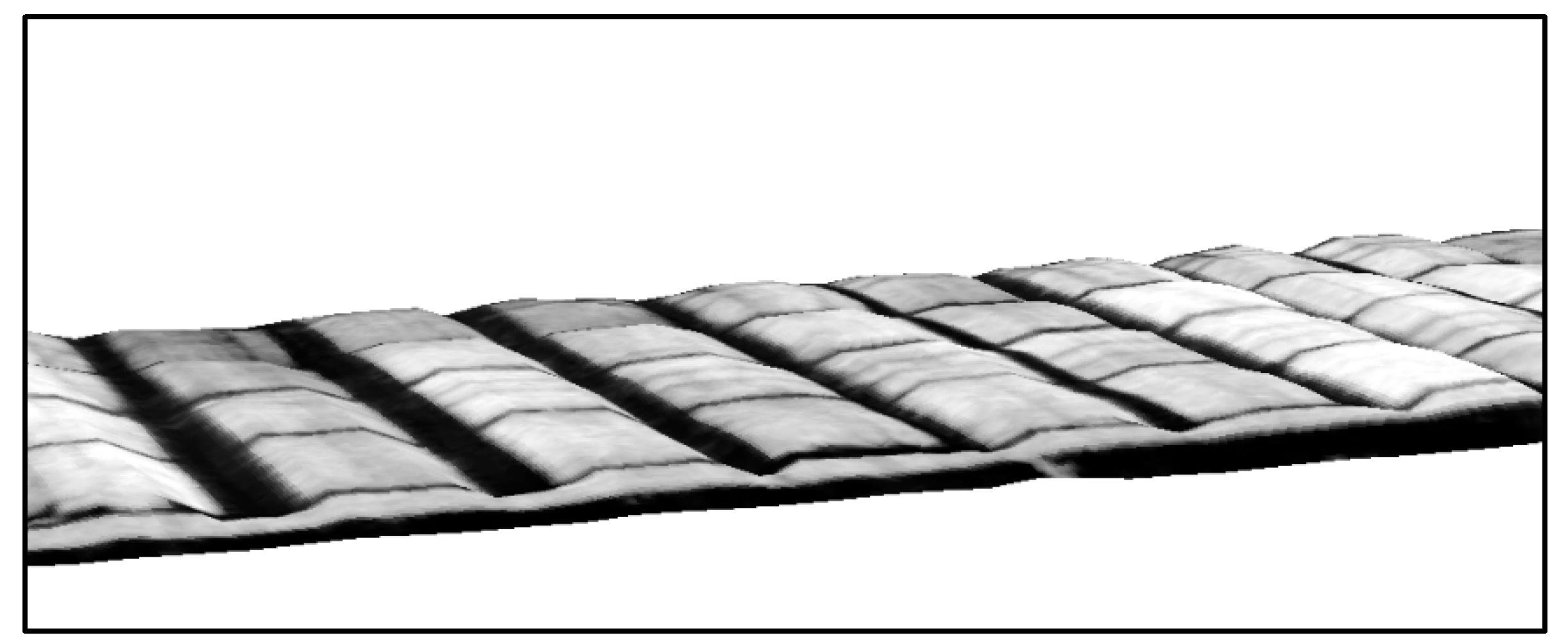
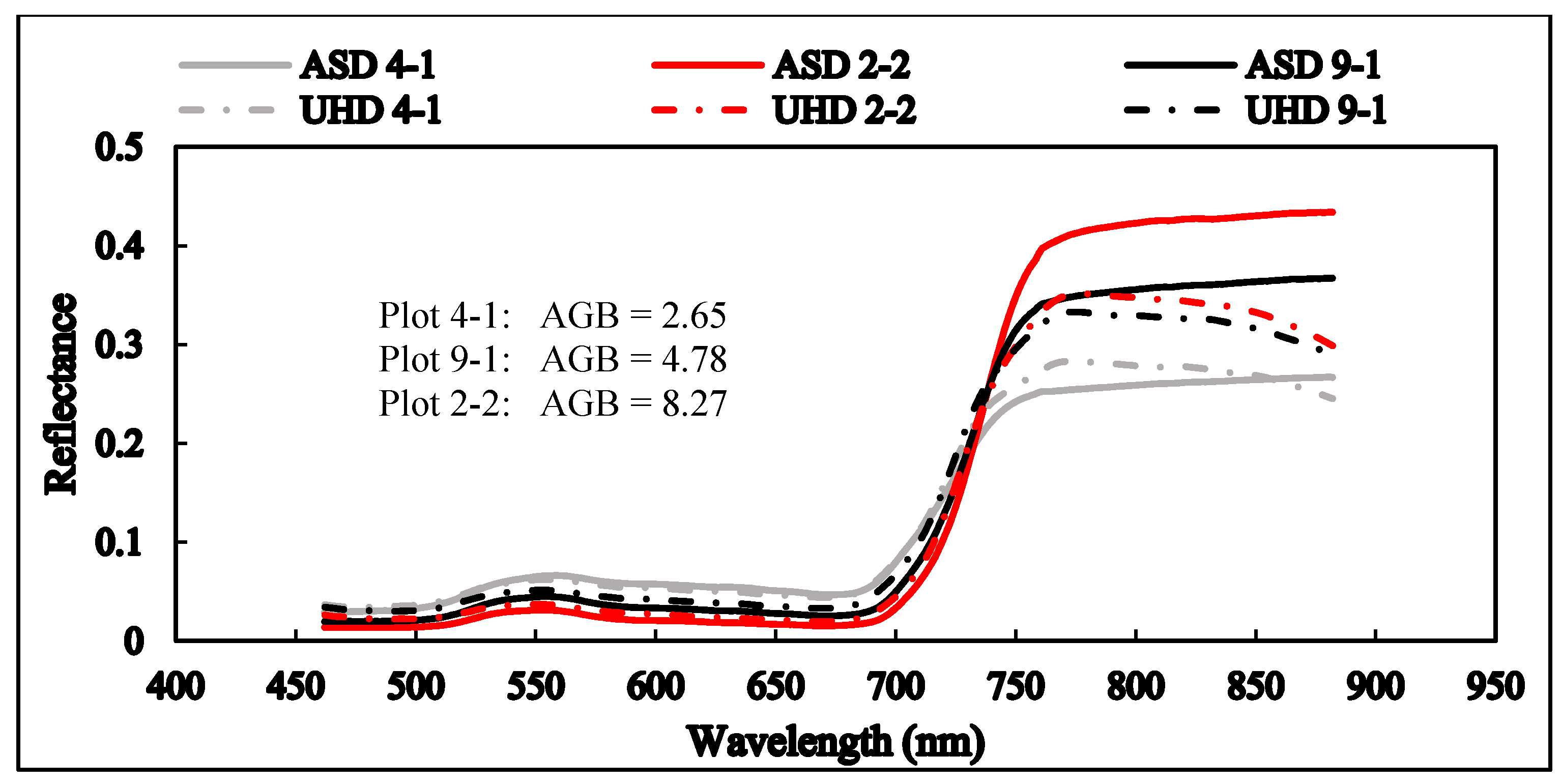
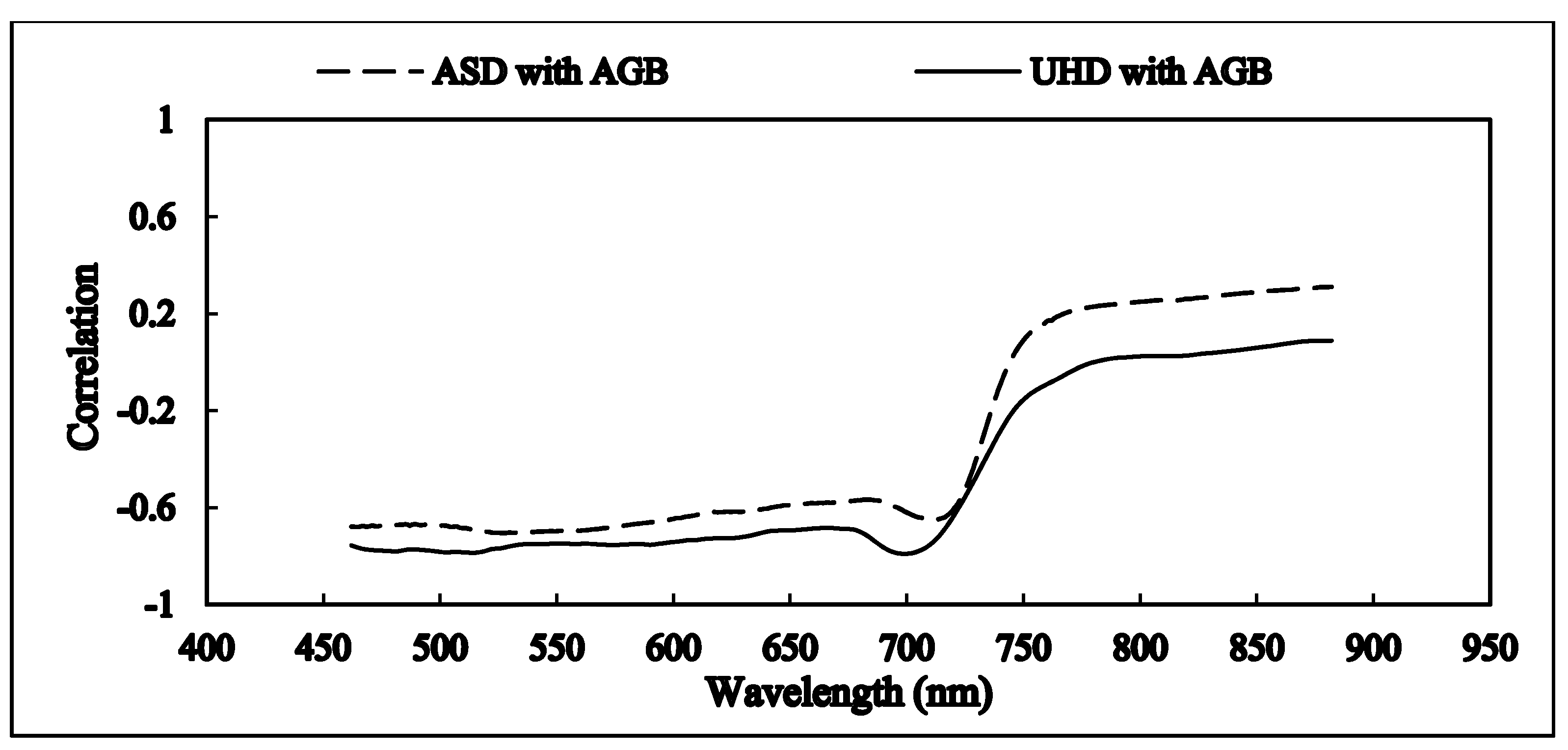
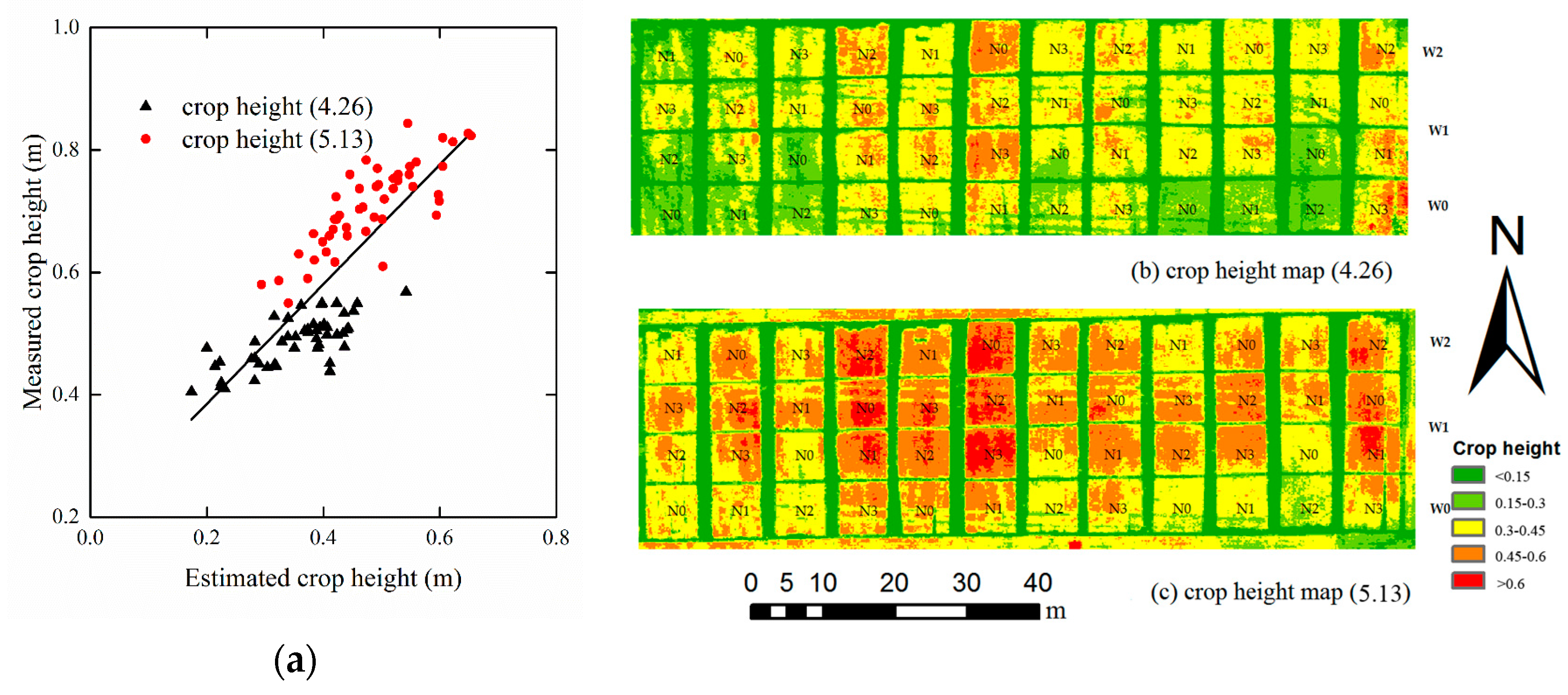
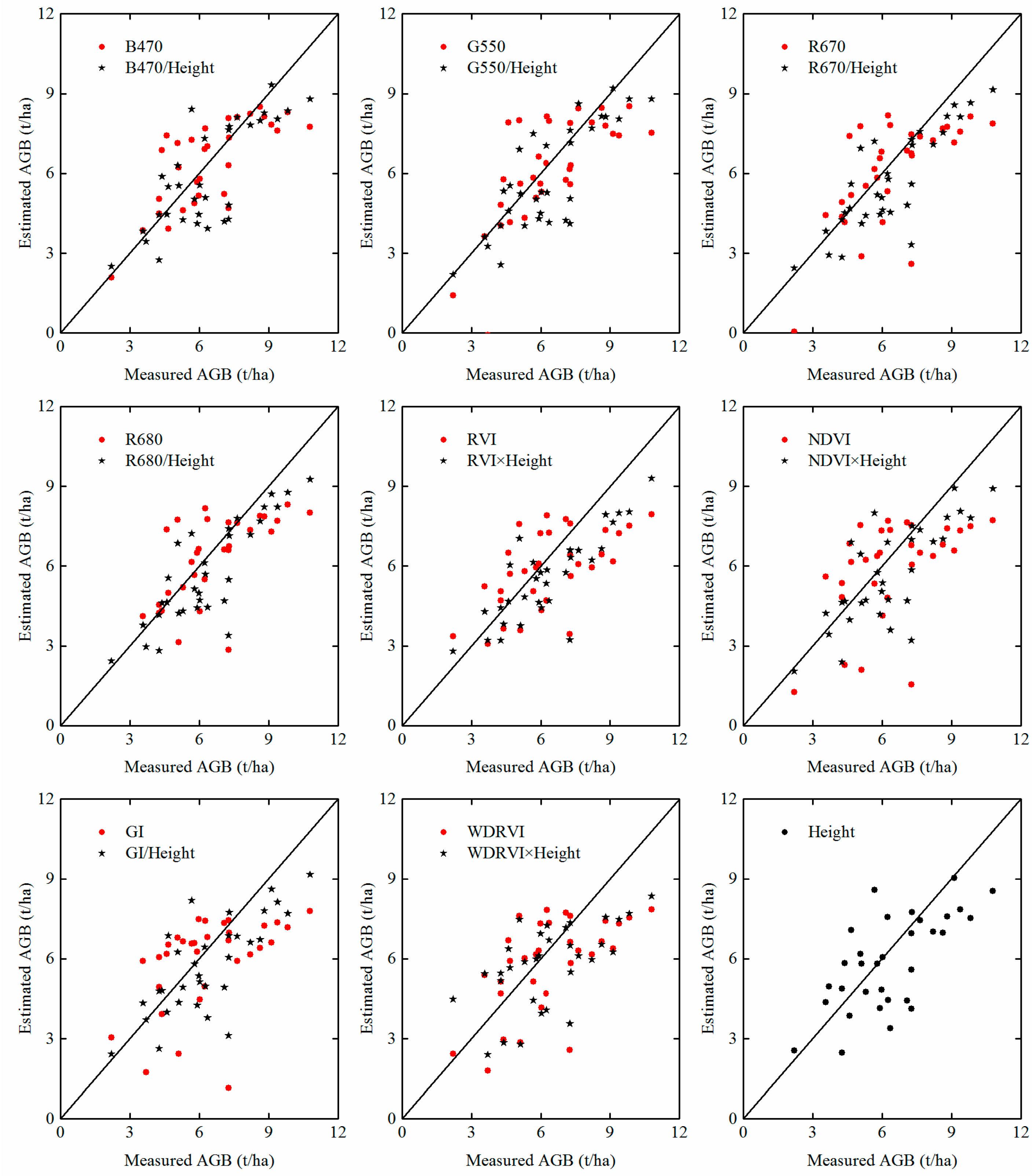
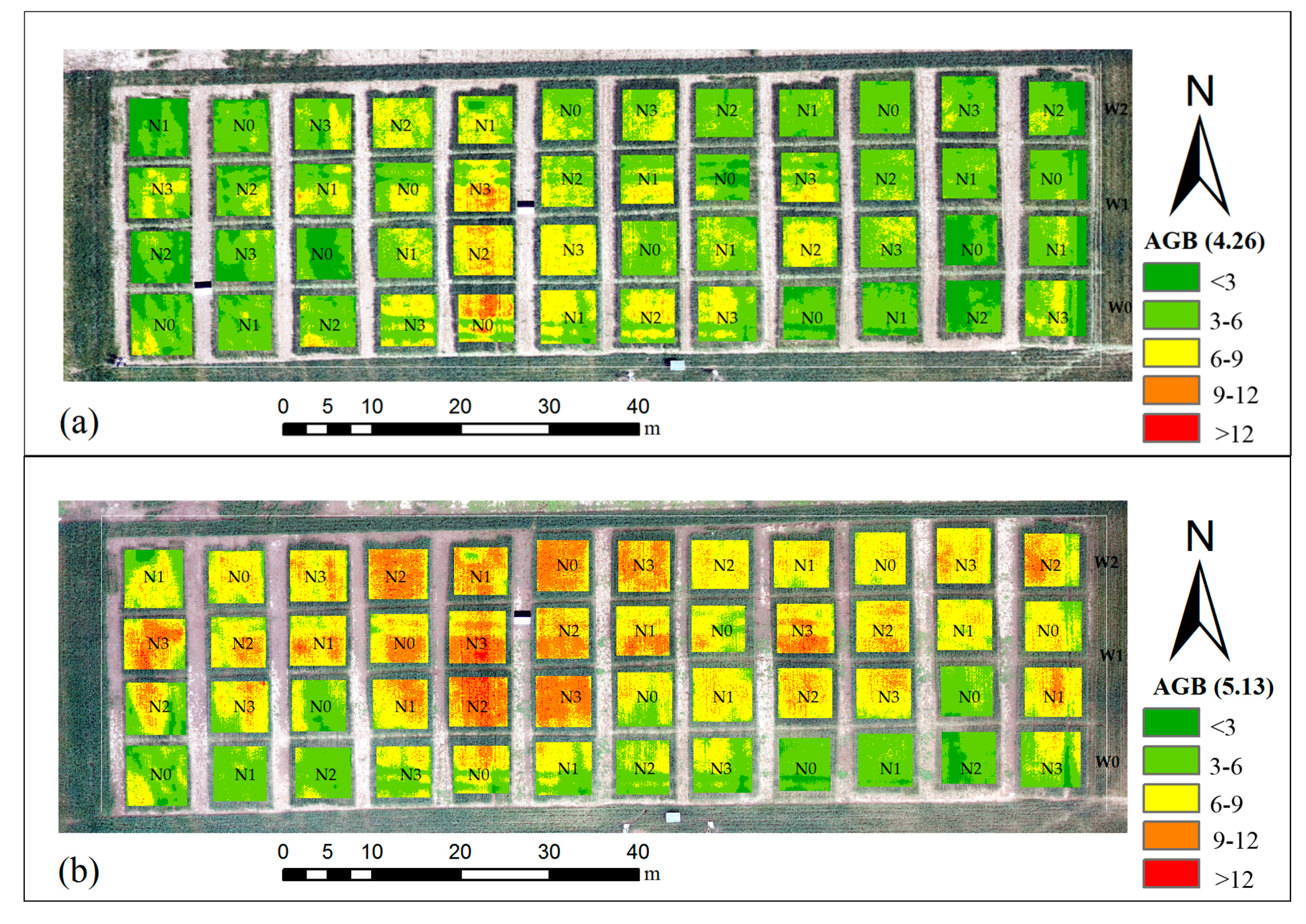
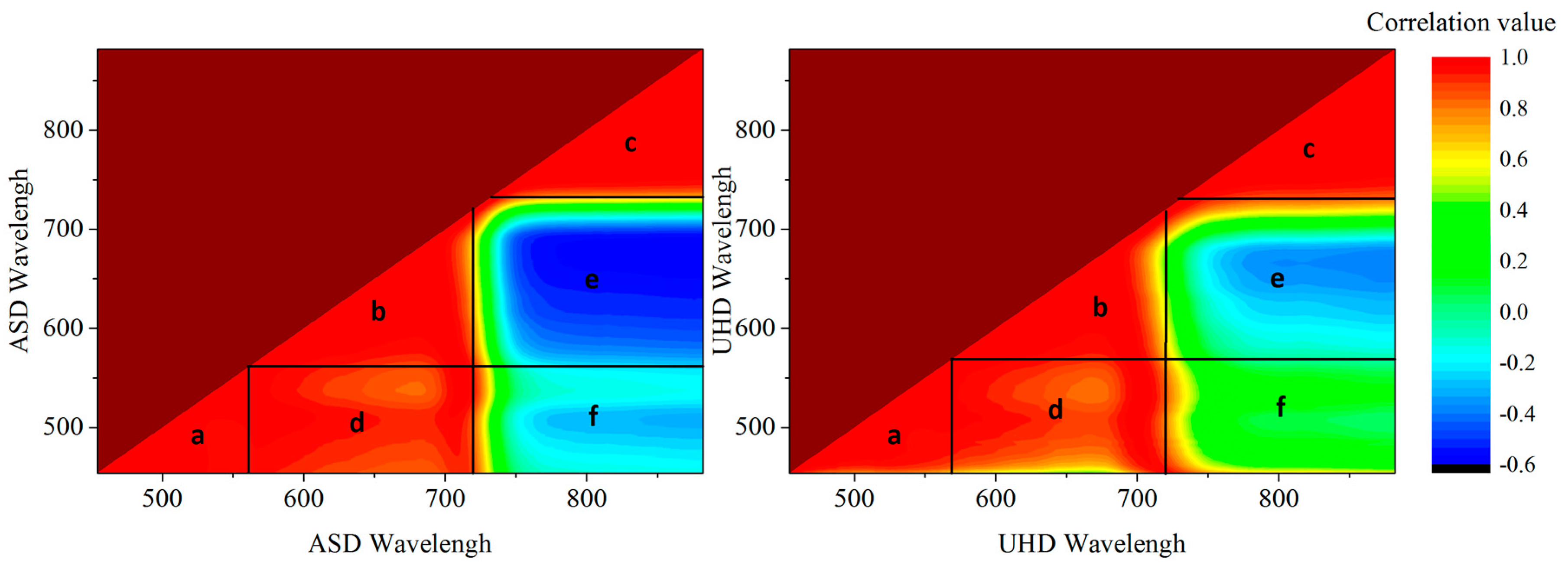
| Spectral Indices | Characteristics and Functions | Definition | Reference |
|---|---|---|---|
| B470 | Reflectance of 470 nm | R470 | [55] |
| G550 | Reflectance of 550 nm | R550 | [55] |
| R670 | Reflectance of 670 nm | R670 | [55] |
| R680 | Reflectance of 680 nm | R680 | [55] |
| Nir800 | Reflectance of 800 nm | R800 | [55] |
| RVI | Ratio of near infrared and red bands | R800/R680 | [55] |
| NDVI | Responds to change in the amount of green biomass and more efficiently in vegetation with low to moderate density | [20] | |
| EVI | Estimate vegetation LAI, biomass and water content, and improve sensitivity in high-biomass regions | [56] | |
| EVI2 | Similar to EVI, but without blue band and good for atmospherically corrected data | [57] | |
| GI | Estimate biochemical constituents and LAI at leaf and canopy levels | R550/R680 | [58] |
| MSAVI | A more sensitive indicator of vegetation amount than SAVI at canopy level | 0.5[2R800 + 1 − ((2R800 + 1)2 − 8(R800 − R670))1/2] | [59] |
| OSAVI | Similar to MSAVI, but more applicable in agricultural applications, whereas MSAVI is recommended for more general purposes | [60] | |
| WDRVI | Estimate LAI, vegetation cover, biomass; better than NDVI | [26] | |
| TVI | Characterize the radiant energy absorbed by leaf pigments (Chls); note that the increase of Chls concentration also results in the decrease of the green reflectance | 0.5[120(R750 − R550) − 200(R670 − R 550)] | [61,62] |
| DVI1 | Reflectance differ of 800 nm and 680 nm | R800 − R680 | [55] |
| DVI2 | Reflectance differ of 750 nm and 680 nm | R750 − R680 | [55] |
| DVI3 | Reflectance differ of 550 nm and 680 nm | R550 − R680 | [55] |
| MTVI1 | More suitable for LAI estimation than TVI | 1.2[1.2(R800 − R550) − 2.5(R670 − R550)] | [61] |
| MTVI2 | Preserves sensitivity to LAI and resistance to Chl influence | {1.5[1.2(R800 − R550) − 2.5(R670 − R550)]}/ {(2R800 + 1)2 − [6R800− 5(R670) 1/2] − 0.5}1/2 | [61] |
| Specific Bands and Spectral Vegetation Indices | Correlation Coefficients (r) | Specific Bands and Spectral Vegetation Indices | Correlation Coefficients (r) |
|---|---|---|---|
| B470 | −0.74 ** | MSAVI | 0.21 * |
| G550 | −0.73 ** | OSAVI | 0.37 ** |
| R670 | −0.68 ** | WDRVI | 0.59 ** |
| R680 | −0.69 ** | TVI | −0.04 n.s. |
| Nir800 | −0.17 * | DVI1 | 0.12 n.s. |
| RVI | 0.60 ** | DVI2 | −0.03 n.s. |
| NDVI | 0.60 ** | DVI3 | 0.12 n.s. |
| EVI | 0.56 ** | MTVI1 | 0.09 n.s. |
| EVI2 | 0.19 * | MTVI2 | 0.27 ** |
| GI | −0.51 ** |
| Models | Details of Models | Modeling Accuracy | |||
|---|---|---|---|---|---|
| Input Variables | Equation | R2 | RMSE (t/ha) | MAE (t/ha) | |
| M1 | B470 | AGB = −343.928 × B470 + 16.181 | 0.58 | 1.48 | 1.19 |
| M2 | G550 | AGB = −201.304 × B550 + 15.953 | 0.56 | 1.52 | 1.18 |
| M3 | R670 | AGB = −212.163 × B670 + 12.687 | 0.54 | 1.55 | 1.23 |
| M4 | R680 | AGB = −204.084 × B680 + 13.059 | 0.59 | 1.47 | 1.17 |
| M5 | RVI | AGB = 0.459 × RVI + 1.467 | 0.38 | 1.79 | 1.53 |
| M6 | NDVI | AGB = 25.036 × NDVI − 14.006 | 0.37 | 1.81 | 1.47 |
| M7 | GI | AGB = −15.193 × GI + 16.792 | 0.30 | 1.91 | 1.55 |
| M8 | WDRVI | AGB = 9.250 × WDRVI + 6.282 | 0.39 | 1.79 | 1.49 |
| M9 | Height | AGB = 12.145 × Height + 0.056 | 0.50 | 1.62 | 1.24 |
| Models | Details of Models | Modeling Accuracy | |||
|---|---|---|---|---|---|
| Description | Equation | R2 | RMSE (t/ha) | MAE (t/ha) | |
| HB470 | Height/B470 | AGB = 0.268 × Height/B470 + 1.163 | 0.71 | 1.22 | 0.96 |
| HG550 | Height/G550 | AGB = 0.476 × Height/G550 + 0.848 | 0.73 | 1.18 | 0.90 |
| HR670 | Height/R670 | AGB = 0.246 × Height/R670 + 1.591 | 0.74 | 1.16 | 0.85 |
| HR680 | Height/R680 | AGB = 0.273 × Height/R680 + 1.567 | 0.76 | 1.12 | 0.82 |
| HRVI | RVI × Height | AGB = 0.723 × RVI × Height + 2.183 | 0.63 | 1.39 | 1.06 |
| HNDVI | NDVI × Height | AGB = 14.300 × NDVI × Height + 0.243 | 0.58 | 1.48 | 1.13 |
| HGI | GI/Height | AGB = 7.072 × GI/Height + 0.821 | 0.58 | 1.48 | 1.16 |
| HWDRVI | WDRVI × Height | AGB = 18.981 × WDRVI × Height + 6.100 | 0.42 | 1.75 | 1.46 |
| Models | Variables | Modeling | Verification | ||||
|---|---|---|---|---|---|---|---|
| R2 | RMSE (t/ha) | MAE (t/ha) | R2 | RMSE(t/ha) | MAE (t/ha) | ||
| PLSR a | HB470, HG550, HR670, HR680, HRVI, HNDVI, HGI and HWDRVI | 0.78 | 1.08 | 0.83 | 0.74 | 1.20 | 0.96 |
| PLSR b | Height, B470, G550, R670, R680, RVI, NDVI, GI and WDRVI | 0.75 | 1.14 | 0.87 | 0.67 | 1.46 | 1.14 |
| PLSR c | B470, G550, R670, R680, RVI, NDVI, GI and WDRVI | 0.64 | 0.37 | 1.09 | 0.53 | 1.69 | 1.20 |
| Models | R2 | RMSE (t/ha) | MAE (t/ha) | |||||||||
|---|---|---|---|---|---|---|---|---|---|---|---|---|
| Modeling | Verification | Modeling | Verification | Modeling | Verification | |||||||
| Before | After | Before | After | Before | After | Before | After | Before | After | Before | After | |
| HB470 | 0.58 | 0.71 | 0.45 | 0.60 | 1.48 | 1.22 | 1.60 | 1.41 | 1.19 | 0.96 | 1.33 | 1.12 |
| HG550 | 0.56 | 0.73 | 0.51 | 0.66 | 1.52 | 1.18 | 1.50 | 1.34 | 1.18 | 0.90 | 1.16 | 1.06 |
| HR670 | 0.54 | 0.74 | 0.51 | 0.70 | 1.55 | 1.16 | 1.52 | 1.28 | 1.23 | 0.85 | 1.17 | 0.99 |
| HR680 | 0.59 | 0.76 | 0.60 | 0.71 | 1.47 | 1.12 | 1.98 | 1.27 | 1.17 | 0.82 | 1.41 | 0.98 |
| HRVI | 0.38 | 0.63 | 0.46 | 0.69 | 1.79 | 1.39 | 1.94 | 1.34 | 1.53 | 1.06 | 1.33 | 1.10 |
| HNDVI | 0.37 | 0.58 | 0.36 | 0.56 | 1.81 | 1.48 | 1.68 | 1.49 | 1.47 | 1.13 | 1.14 | 1.17 |
| HGI | 0.30 | 0.58 | 0.31 | 0.56 | 1.91 | 1.48 | 2.02 | 1.48 | 1.55 | 1.16 | 1.68 | 1.18 |
| HWDRVI | 0.39 | 0.42 | 0.24 | 0.35 | 1.79 | 1.75 | 1.94 | 1.73 | 1.49 | 1.46 | 1.58 | 1.51 |
© 2017 by the authors. Licensee MDPI, Basel, Switzerland. This article is an open access article distributed under the terms and conditions of the Creative Commons Attribution (CC BY) license (http://creativecommons.org/licenses/by/4.0/).
Share and Cite
Yue, J.; Yang, G.; Li, C.; Li, Z.; Wang, Y.; Feng, H.; Xu, B. Estimation of Winter Wheat Above-Ground Biomass Using Unmanned Aerial Vehicle-Based Snapshot Hyperspectral Sensor and Crop Height Improved Models. Remote Sens. 2017, 9, 708. https://doi.org/10.3390/rs9070708
Yue J, Yang G, Li C, Li Z, Wang Y, Feng H, Xu B. Estimation of Winter Wheat Above-Ground Biomass Using Unmanned Aerial Vehicle-Based Snapshot Hyperspectral Sensor and Crop Height Improved Models. Remote Sensing. 2017; 9(7):708. https://doi.org/10.3390/rs9070708
Chicago/Turabian StyleYue, Jibo, Guijun Yang, Changchun Li, Zhenhai Li, Yanjie Wang, Haikuan Feng, and Bo Xu. 2017. "Estimation of Winter Wheat Above-Ground Biomass Using Unmanned Aerial Vehicle-Based Snapshot Hyperspectral Sensor and Crop Height Improved Models" Remote Sensing 9, no. 7: 708. https://doi.org/10.3390/rs9070708





